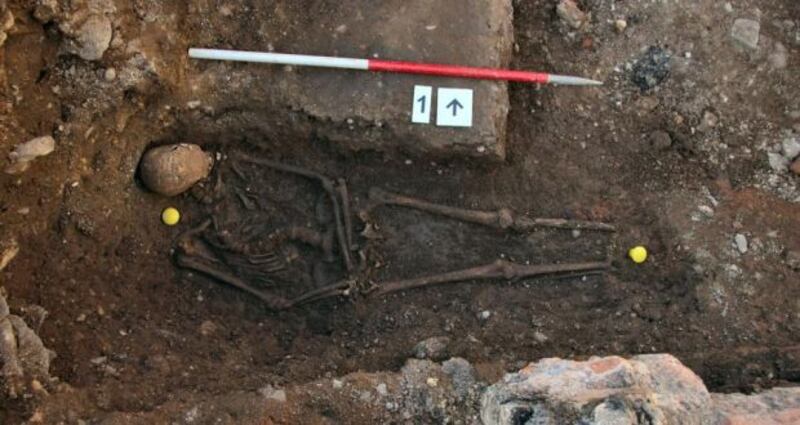England’s King Richard III, whose body was remarkably discovered under a municipal car park, will be reburied near to where he was slain in battle 500 years ago, a court ruled today, dashing the hopes of his distant descendants who had wanted his remains to be taken back to his northern stronghold.
The unearthing two years ago of the remains of the last English king to die in battle was one of the most important archaeological finds of recent years.
Richard was slain at Bosworth Field near Leicester, central England, in 1485, bringing to an end the rule of the Plantagenet dynasty after 300 years.

His death was the culmination of the Wars of the Roses, a bloody 30-year power struggle between Richard’s House of York and the rival House of Lancaster.
The whereabouts of his grave had been a mystery until a skeleton with curved spine and head wounds was found by archaeologists from the University of Leicester, with DNA tests confirming it was indeed the king.
The university was given permission by Britain’s Ministry of Justice to re-bury the king at Leicester cathedral.
But the Plantagenet Alliance, a group which included some of Richard's distant descendants, asked London's High Court to block the burial plans, arguing the decision on the final resting place should have been a matter of public consultation.
They wanted their ancestor to be reinterred in the northern city of York, his power base during his 26-month reign.
However, their case was thrown out by three of the country’s most senior judges today.
“Since Richard III’s exhumation of September 5th, 2012, passions have been roused and much ink has been spilt,” their ruling said.
“We agree that is it is time for Richard III to be given a dignified reburial and finally laid to rest.”
A tough soldier and popular in the north, Richard remains a hugely divisive figure in English history, seen by some as a monster who murdered two princes - his own nephews - in the Tower of London to take the throne, and by others as an enlightened ruler unfairly maligned by his enemies.
He was cast by Shakespeare as a power-crazed hunchback, who famously went down fighting to keep his crown from the invading forces of Henry Tudor crying out "A horse! A horse! My kingdom for a horse!".
After the battle, the victor, the future King Henry VII, had Richard’s naked body exposed to the people of Leicester to show the battle was won before he was buried in a monastery which was later destroyed.
In their ruling, the three judges said Queen Elizabeth was content for the dead king to be buried in Leicester, and did not express a wish for a royal funeral or for a re-interment at London's Westminster Abbey where many medieval monarchs were laid to rest.
The judges also said the Plantagenet Alliance, set up by Stephen Nicolay, the 16th-great-nephew of Richard, represented only a fraction of the number of his descendants.
The alliance said in a statement after the ruling: “We believe that the proposed location of Leicester is wholly inappropriate for the burial of King Richard III, who had no connections with the town beyond his horrific death, bodily despoliation and appalling burial in a foreshortened grave.
“It is fitting and respectful and in keeping with all of our national customs regarding treatment of the dead, to bury this king in a place ‘appropriate to him’ - that place is York.”
The University of Leicester will now go-ahead with plans for the reburial, likely to be early next year, while the city council has unveiled plans for a £4 million pound (€4.95 million) visitor centre around the find, hoping that fascination with the monarch will prove to be a hit with tourists.
"Ultimately a King of England by right of conquest - Henry VII - decided in August 1485 to hand over the vanquished King Richard's remains to the Franciscan Friars in Leicester for burial," said Richard Buckley, the archaeologist who led the dig which discovered the body.
“There they have lain for over half a millennium and have become part of Leicester’s history. Long may this association continue.”
Reuters











